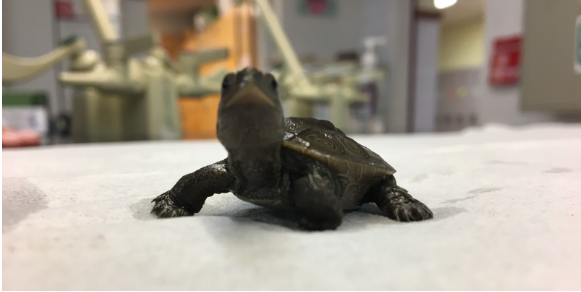Project Terrapin: A Head Start

A picture of a Diamondback Terrapin
What is a terrapin? The Diamondback Terrapin is a species of turtle native to the brackish coastal tidal marshes of the eastern and southern United States. Terrapins are a species of special concern which means they are struggling in the wild to have “long-lifespans” due to natural threats like other animals and due to negative human impact. This year, Madison High School sought out to help the terrapins in Island Beach State Park by following the Marine Academy of Technology and Environment Science’s Head Start Program.
So what’s the problem? What happened to the terrapins of Island Beach State Park? Why is the population declining so rapidly? One of the reasons is predators. Diamondback Terrapin nests are preyed on by skunks, raccoons, and foxes in the area. And when the baby terrapins come out of the nest, they are often eaten by gulls, crows, and other birds. Although the hatchlings are less vulnerable to predation when in water, they can still be preyed on by predatory fish. Another threat to terrapin survival is humans. Human activity around marches has caused habitat erosion and has eliminated nesting grounds. Besides their habitat, terrapins are also directly affected by man-made things like crab traps which cause drowning and cars which can run them over.
What is Project Terrapin? At Island Beach State Park and N. Sedge Island, researchers have been working with terrapins the past fifteen years and have documented a decline in the population. Because of this research, the Marine Academy of Technology and Environment Science made a mission of assisting the Terrapins. They created the Head Start Program, terrapin sighting forms, turtle excluder devices, road signs, turtle gardens, and more; in an effort to slow, and hopefully reverse, the decline.
What is the Head Start Program? Schools in New Jersey adopt terrapins and bring them into their school to give them a head start in life by letting them grow domestically. “Giving them a head start by providing them with nourishment and proper living conditions gives them a chance to succeed in their natural environment to hopefully increase the population of terrapins in the long run,” says science teacher Mrs.Spangler. When they are ready, and grown enough, they will be released back into the wild more able to endure the threats. Students and teachers will be responsible for feeding, cleaning tanks, providing heat and UV lamps, maintaining proper water salinity, as well as recording their growth (measuring and weighing hatchlings throughout the year). The purpose being to release all the terrapins back into the wild with a head start by the end of the year.
How does this project relate to Ecology class and other sciences? Project Terrapin gives students hands on experience with nature, animals, and the environment rather than just reading textbooks and listening to slide show presentations. “The terrapins tie into a lot of different aspects of our curriculum like food chains, food webs, biology, ecology, and environmental science because we can talk about human impact on the environment and conservation. Project aware can be involved with helping the terrapins too,” says science teacher Mrs.Lieu. It also shows students the positive effect they can have on organisms and that they can make a difference no matter how small the act. The hatchling Head Start Program provides classrooms with an opportunity to help ensure terrapin population stability in the study area as well as provide an opportunity for stewardship.
adviser • Dec 6, 2018 at 11:10 am
Glad to see that MHS is taking the initiative to help these species in need.